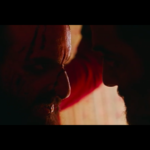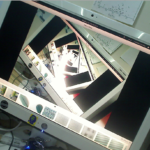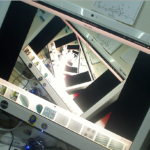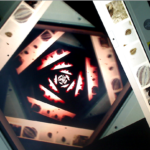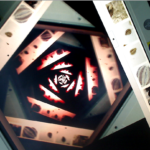Ages in Chaos is a scientific biography of James Hutton by Stephen Baxter. Hutton was a Scottish scientist who also played his part in Scottish enlightenment. Hutton was the first to speculate on the idea deep time required for geological processes at the end of 1700s arguing with evidence he collected. He was trained as a medical doctor, practiced farming for 10 odd years and had continued his explorations of geology throughout. The prevalent theories of geology, called Neptunists, posited that water was the change agent. Hutton on the other hand posited that it was heat which was responsible for changes, hence Vulcanists. Also, another thing was that of time needed for this change. As others of his era, Hutton was deeply religious, like Newton, wanted to find evidence for creation as per bible.
During his time, especially popular was the idea of flood as per Bible, while the Earth was literally considered to be 6000 years old. This created a problem for Hutton, who was labelled to be atheist and heretic for suggesting that Earth is much older and that there was no design. But Hutton was a conformist and wanted to find a uniform evidence for all observable aspects. He was not like a modern scientist, as he is painted many times. The ideas were vehemently attacked on each point. Though he went to the field to find geological examples for this theory. James Watt, Black and John Playfair were his friends and provided him with evidence in the form of rock samples. During his lifetime, Hutton’s ideas will not find much audience. But due to his friends, his ideas sustained a a barrage of criticisms. Only in the next generation with Lyell this work would find acceptance. This idea of a deep time was crucial in formation Darwin’s theory.
https://www.goodreads.com/book/show/157978.Ages_in_Chaos
The book reads well mostly, but at times a complete lack of illustrations in the forms of geological artefacats and maps (of Scotland) makes it difficult to read well.
review
Book Review: Pendulum: Léon Foucault and the Triumph of Science by Amir D. Aczel
The book traces Leon Foucault’s ingenious approach to solving the problem of providing a terrestrial proof of rotation of the Earth. The pendulum he devised oscillates in a constant plane, and if properly engineered (as he did) can actually show the rotation of the Earth. The demonstration is one the most visually impressive scientific experiments. Also, Foucault gave prediction, an equation which would tell us how the pendulum will behave at different parts of the Earth. The pure mathematicians and physicists alike were taken aback at this simple yet powerful demonstration of the proof which eluded some of the most brilliant minds, which includes likes of Galileo and Newton. Rushed mathematical proofs were generated, some of the mathematicians earlier had claimed that no such movement was possible. That being said, Foucault was seen as an outsider by the elite French Academy due to his lack of training and degree. Yet he was good in designign things and making connections to science. This was presented to the public in 1851, and the very next year in 1852 he created another proof for rotation of the Earth. This was done by him inventing the gyroscope.. Gyroscope now plays immense role in navigation and other technologies. Yet he was denied membership to the Academy, only due to interest of the Emperor Napolean III in his work in 1864. The pendulum is his most famous work, but other works are also of fundamental significance.
- He was first person to do photomicrography using Daguerreotype
- Accurate measurment of speed of light using rotating mirrors –
- Devised carbon arc electric lamp for lighting of micrcoscope
- One of the first to Daguerreotype the Sun
- Designed the tracking systems used in telescopes
- also designed many motors, regulators to control electrical devices
There are a couple of places in the book where Aczel seems to be confused, at one point he states parallax as a proof for rotation of Earth around its axis, whearas it is more of a proof of Earths motion around the Sun. At another place he states that steel was invented in 1800s which perhaps he means to say that it was introduced in the west at the time. Apart from this the parallels between the rise of Napoleon III, a Nephew of Napolean, to form the second Empire in France and Foucault’s own struggle for recognition of his work and worth is brought out nicely.
Review of Laal Kaptaan
Recently I saw the movie Laal Kaptaan (लाल कप्तान, literal translation Red Captain). Though I had seen the trailer when it was released sometime back this year, I did not see the movie. The visuals in the trailer were quite good, so I decided to finally watch it. And I was not disappointed. This is one of the few movies in recent times that I have managed to see in one shot. Or rather the movie managed to make me do it.
The major part of the movie is set in the region of Bundelkhand (literally the dominion of the Bundelas). This region which falls South-East of Agra and Delhi has historical places like Jhansi, Gwalior, Panna, Chhatarpur, Banda and Orchha within its folds has been historically important. The province of Awadh (Oudh) lies to the east of Bundelkhand and Ganges marks the boundary to the East, while the Rajputana lies to the West. The Yamuna divides the region into two, with the majority of the part lying to the West of Yamuna. The region between the two mighty rivers is known as a doab (marked yellow in the map below). Many of these were erstwhile princely states, which also existed until 1947, when they were merged with the Indian republic.

The era when the Mughal empire was disintegrating post the death of Aurangazeb in 1707, was especially tumultuous for this region. With the power vacuum created by the decaying Mughal empire being filled by the Marathas, by this time the Chatrapati was only a titular head and real power rested with the Peshwas and the various great houses of the Marathas (Shinde, Holkar, Bhosle, Gaikwad). The Marathas laid waste to large tracts and levied chauth ( collection of one-fourth of income ) on these regions mercilessly. But in general, they were hated in this region for their bullishness and general havoc they perpetrated on the public and places. For example, they looted the Red Fort in Delhi with impunity, scrapping off precious and semi-precious stones from the Diwan-e-Khaas to do a vasuli. (I might make a dedicated post for this later.)
If the Battle of Plassey (1757) was the founding stone of the British in India, then the battle of Buxar (1764) was the first real fortification of this foundation, and the British really established themselves in India as a potent force. Though the Marathas were the most powerful, the British did not engage with them directly until the end of the century. The third Battle of Panipat (1761), a few years before the battle of Buxar limited the Maratha presence in the North severely and was one of the major reasons that led to its full demise as a political and military power by the start of the next century. Though, this enabled the houses of Shinde, Holkar, Bhosle and Gaikwad to establish their own semi-independence over the Peshwas. Eventually, everyone became under the British. But the time in which the movie is set, the Marathas were still a force to reckon with and the EIC has just established itself as a millitary and political power in much of the region from Bengal to North India along the Gangetic plains.
The movie starts just after the Battle of Buxar (1764) when a large number of people are hanged outside the fortress of Shergarh (most probably a fictional place, as I could not find it anywhere in the sources). after the British win the battle. One of the persons who sides with the British named Rehmat Khan is especially despised upon, with him being called a gaddar (traitor) by the hanged. The accused are hanged on a huge banyan tree, with their bodies hanging like overgrown fruits along its branches. It is raining and in this scene, a young teenage boy promises Rehmat Khan that one day he will also hang on the same tree.
Fast forward 25 years (1789), we are taken to the den of a dacoit (डकैत /डाकू ) where the Bairagi called by another generic name Gossain (this term I had not heard before this film). He comes in and asks for fire for his chillam. Mayhem ensues and the hunter takes his prey. The entire scene starts with dark of the night and ends in the early morning.
The horde of warrior ascetics (of which were the Gossain/Naga) came to prominence in the resulting political instability and shifting sands post the fall of the Mughal empire.
…these orders became politically significant only after the collapse of the Mughal Empire, and more particularly after British activities created political and economic chaos in the second half of the eighteenth century.
Going forward, the hunter goes on to take his reward, where the local chieftain mocks him and doesn’t want to pay. He is made to pay by the Gossain. The film then follows the Gossain on his quest to locate and kill Rehmat Khan. Though there are hints that there is a link between the Gossain and the teenage boy who is hanged in the beginning, we are not sure how they are connected. I won’t go into the plot of the film, but will instead focus on some of the characters and background of the film.
Though some of the other reviews have portrayed the character of Rehmat Khan (played by Manav Vij) as just grunting. But I think he played the role very well, perhaps these reviewers are used to seeing villains as people who yell and show a lot of emosions on their faces. He subtly played the act of a cold-blooded, calculating and cruel character quite well and was never out of character. Rehmat Khan is a Rohilla. Now, the Rohillas were of an Afghan ethnicity, and they sided against the Marathas (led by Najib ad-Dawlah) with Ahemdshah Abdali during the third battle of Panipat. The Marathas were very enraged by this and Mahadji Shinde did collect his revenge on them a few years in 1772 after Panipat by destroying Rohilkhand and scattering bones of Najib ad-Dawlah. After this defeat, the First Rohilla war happened in which the British siding with the Nawab of Oudh defeated the Rohillas and the state of Rampur of established. The second Rohilla war, in 1794, between British and the Rohillas ended their supremacy in the region. Now, the time between the two wars, there was lot of guerilla activity carried out by the Rohillas, which led them to be set as Nawabs of Rampur. Given all this chaos and uncertainty, there were no permanent alliances or allegiances. The main part of Laal Kaptaan (c. 1789) is set in this era for the Rohillas. So, Rehmat Khan, a prominent Rohilla, defecting over to British was noteworthy, but not out of the line.
Pindaris
Pindaris were not a tribe, but a military system of bandits of all races and religions. They fluctuated in numbers, being augumented from time to timeby military adventurer from every State, and frequently amounted to as many as 30,000 men.
Pindaris present an episode in history of India, which is quite extraordinary, though skimmed upon in the history texts. Here we are witnessing a rise of a band of people whose existence was based on terrorising and looting people in distant provinces. The Pindaris were roughly active in the last three decades of eighteenth century to the first two decades of nineteenth. Earlier they were under tutelage of Maratha cheiftains who used them as militias to wreck havoc on supply lines of the enemies and disrupt civilian peace. So them accompanying the Maratha camp is completely normal. The depiction of the Pindari lust for the loot (tum log lo khazana, mai chala lene zanana) is well done in the film. In fact, the comedy of errors that the bunch sent to hunt down Rehmat Khan is something to relish. The frustration of the little Maratha knight in being unable to control them is well worth seeing.
But as the Maratha power came to a decline, the Pindaris in the nineteenth century became a force of their own, without masters. They would raid far, and were viscious and cruel in their tactics to make people pay. There are reports that people even committed suicides when they came to know that a Pindari raid was imminent.
Another thing worth mentioning in the film is the settings in which the film is shot. The cinematography is par excellence, set amongst fantastic fort ruins. I cannot identify the actual locations used in the film, so any information on that would be welcome.
The other character in the film worth mentioning is the Dog Walker played by Deepak Dobriyal. He has a pair of very fine Mudhol hounds (also known as Caravan hounds) named Sukhiram and Dukhiram.
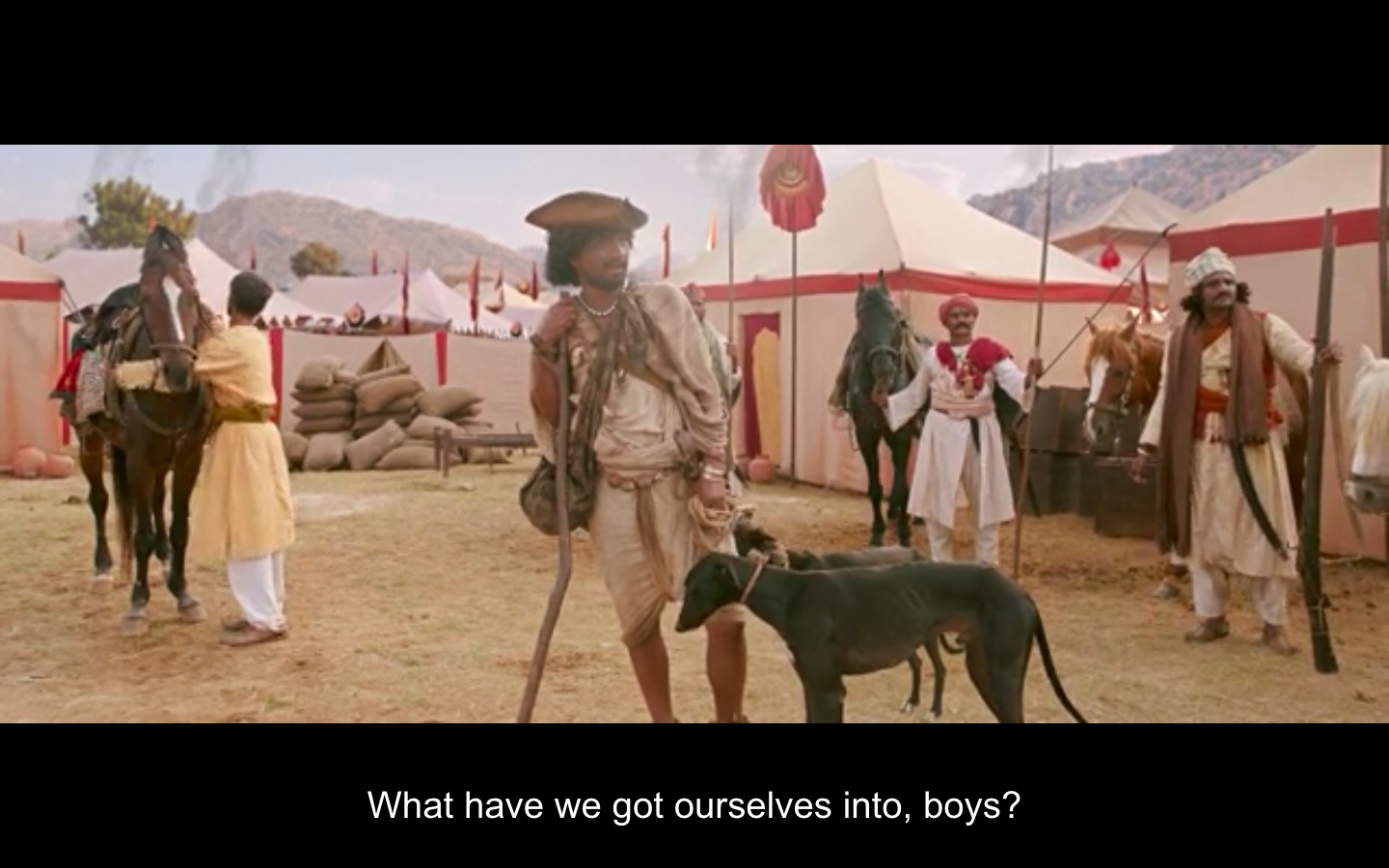 The character has no name in the film, but he finds people who are wanted for a price. That is how he makes his living. He refuses a horse mount saying it interferes with His character has many layers and he shares a special relationship with the Gossain, they respect each other. It was a treat to watch Dobriyal play this character with English hat and his greeting of:
The character has no name in the film, but he finds people who are wanted for a price. That is how he makes his living. He refuses a horse mount saying it interferes with His character has many layers and he shares a special relationship with the Gossain, they respect each other. It was a treat to watch Dobriyal play this character with English hat and his greeting of:
Howde do…

The two female characters in the film, one played by Zoya and other by Heena are in their niche. Zoya as a courtesan who is neglected, while Heena playing the wife of a chieftain carries herself well. Their characters are in emotional turmoil with maternal love and the surrounding situation.


The clothing, the artefacts are all era-appropriate and so are the languages used. A lot of work must have gone in background research and it shows in the quality of the film. Kudos to the production team for that. Just that the look of Saif has a semblance to Depp’s Jack Sparrow, that could have been avoided.
Overall a very watchable film, if you have not, do watch it.

PS: A special ode to Saif Ali Khan.
In my personal opinion, Saif Ali Khan has really matured as an actor over the years and has earned my respect for it. You can’t really compare his role in Yeh Dillagi and lets say his depiction of Langda Tyagi in Omkara. It is as if you are watching two completely different actors. The variety of roles he has done in recent times, and with grace is just amazing. He has done roles which many of the mainstream actors would shy away from. Hope that we see his good form in the future also.

References
Another Life – a review
I recently saw (or tried to) a sci-fi series titled Another Life on Netflix. The basic premise is in the first contact schema, wherein an alien spacecraft lands on Earth in the near future. The alien spacecraft looked cool, a rotating infinity sign. The promo and visuals looked nice hence I decided to watch.

The alien spacecraft lands and builds a crystal tower.
 It is not communicating and experts are trying to communicate with it via infrasound. The lead scientist here is the husband of the main protagonist Niki (who is captaining the spaceship Slavere being sent to investigate). So both are involved one in space and one on Earth in the matter. Now, no one is aware of whether the aliens are benevolent or malicious. They finally get to communicate with it by playing Western classical music, while the Salvere is en-route to its destination Pi Canis Majoris. So far so good.
It is not communicating and experts are trying to communicate with it via infrasound. The lead scientist here is the husband of the main protagonist Niki (who is captaining the spaceship Slavere being sent to investigate). So both are involved one in space and one on Earth in the matter. Now, no one is aware of whether the aliens are benevolent or malicious. They finally get to communicate with it by playing Western classical music, while the Salvere is en-route to its destination Pi Canis Majoris. So far so good.

Yet, I couldn’t get to like the series. I expected the show will gather plot and pace, once I get past the first few episodes. This happened to me in the case of The Expanse, it turned out to be really good after the first few episodes). The series sort of grows on you, but not this one, at least not for me.
The first offputting thing was the design of the space-ship Salvere. It is supposed to be the most advanced and well-equipped ship yet design-wise the ship is absolute crap. In the control room of the ship, all the crew is standing. Yes, standing! And when the ship does some somersaults, people and things get thrown off-board. I mean a simple design sense would dictate that there must be seats, especially in an artificial gravity ship which undergoes tremendous acceleration, but no, it instead goes

Space saftey 101: no seatbelts
Incidentally, the only person who is standing in the picture above is the holographic projection of the anthropomorphic computer named William onboard the ship. Hence, no inertia (well, technically speaking we are not in the GR domain) and hence sudden accelerations don’t affect him. I thought this would have been a one-off incidence, but things kept getting worse. After a mutiny, Niko kills her second in command over a decision which she takes a call which is not supposed to be tough enough. Was no psychological evaluation done? The highly trained team (including the computer) looks like it is a bunch of teenagers high on hormonal imbalance. They loose a lot of resources while trying to get a slingshot from Sirius. The scene of Niko looking at Sirius through an observation deck is strange. Sirius in all its blue glory (temperature equivalent of 9500 K) is seen overshadowing the observation port, yet the light on her face is equivalent to 5500 K, the colour of golden hour.


Blue light but yellow effect!
The pic in the middle is how the face is lit in the blue light of Sirius is shown in the series, right at least how it should be like. Perhaps the director is too heliocentric.
Now they are off to a planetoid they discover randomly moving across space to mine for crystals which contain a lot of water. I mean how much two people in spacesuits can mine by hand? Surely not enough to fulfill the requirements of a spaceship.

This big suitcase will carry all our requirement of oxygen and hydrogen.
Anyways they come back in a hurry because of a life-threatening “earthquake” on another planet. One of the members of the crew is infected with a boron-based virus that kills one of the staff and infects all of them. The nervous system coming out of the host is one gruesome scene, though reminiscent of H. R. Giger‘s creature emerging from the host in Aliens. The crew discovers that it is airborne and the entire ship is infected with it. Then they find a cure that irradiating by gamma rays will kill the virus. Ergo the electromagnetic shields are brought down so that gamma rays from Sirius can enter the ship and disinfect it. If anything, gamma rays are not affected by electromagnetic fields at moderate levels, though they are electromagnetic in nature. They are not visible to us, neither we can feel them immediately.

Achtung: Gamma ray march begins!

Constipating out boron-based virus with gamma radiation
Yet the crew is bathed in a white light of gamma rays, and after contortions of their faces as if constipating they are cured. Magically no radiation sickness happens. How their own DNA and on-board electronics are not fried is a question worth pondering.
Moving forward, they discover a similar signal to the one earth coming from one of the moons. They find extraterrestrial life there. Which surprisingly is very much like the earth, including its atmosphere and also has liquid water. Now thankfully, at least they are not drawing water by bucket, but by a spaceship.

A nice-cozy stroll on an unknown alien planet teeming with alien life
They find a planet full of alien life, and yet their reaction is so underwhelming. Read this statement in an as dead and as serious and slow voice you can
The excitement is killing me.
They rely completely on the computer to run the scans for any bio-hazard and find no problems at all. This is rather strange, I mean you are effing landing on an alien planet full of alien life and yet you don’t even put a spacesuit? Elementary error. They are not even bothered by the eerie similarity of the planet with earth, neither want to investigate the biochemistry. A rather strange (and dull) space crew who is not thrilled by the discovery of ET life. Through the day, they see only plant life. Even taste fruits by rubbing them on the skin and the licking a bit before eating! C’mon.
At the day end, they are attacked by alien animals (hexpods). They somehow get back to the spaceship without being eaten. And they are scanned and decontaminated, and yet an alien offspring manages to get onboard. So much for the decontamination and the automatic facility.

 Then who am I?
Then who am I?
A few moments later, the friendly onboard computer loses its circuits. And gravity goes off in the section where Niko is working. And she floats upwards… No magnetic boots on board a spaceship in zero gravity!? I mean this is not even wrong.

Look no hands and I am floating.
Now, the artificial gravity on board Salvere is induced by rotation of the ship. In order to remove it, you will have to stop the rotation and it will affect the entire ship. But here it is hown to affect only one room, while in the next room it is normal. Gravity cannot be turned on or off at will. It stays.
About the warp speeds and lights years, they show the ship can travel. We are told it is 3 months onward and 3 months return journey (a total of six months). Considering that Sirius is at about 8 light-years, it has to be a warp drive. As even going at very high speeds will take certainly more than 8 years, one way. But then if it is indeed a warp drive, why do we need that much time? Also, the ship has a sleeping/hibernating soma technology about which also I can rant, but won’t. There is another parallel plot developing on Earth with the crystal tower and trying to communicate with it, which I found even more boring.
I gave the serial a try for 5 full episodes but cannot do this further. If it cannot get its act together by this time, I guess it won’t in the future. It is a torture to watch so many commonsensical and scientific principles getting butchered. When there are so many amazing sci-fi stories that can be serialised, why these without any depth or even elementary sense are being made?
If I had to write, at least I would not make such elementary scientific blunders or plot with so many holes. Maybe I should write one, perhaps I have enough negative expertise on this topic now so that it won’t be as bad as some of them. Phew! I just stop it here as one of the bad-mouthing characters in the series sums it up for me
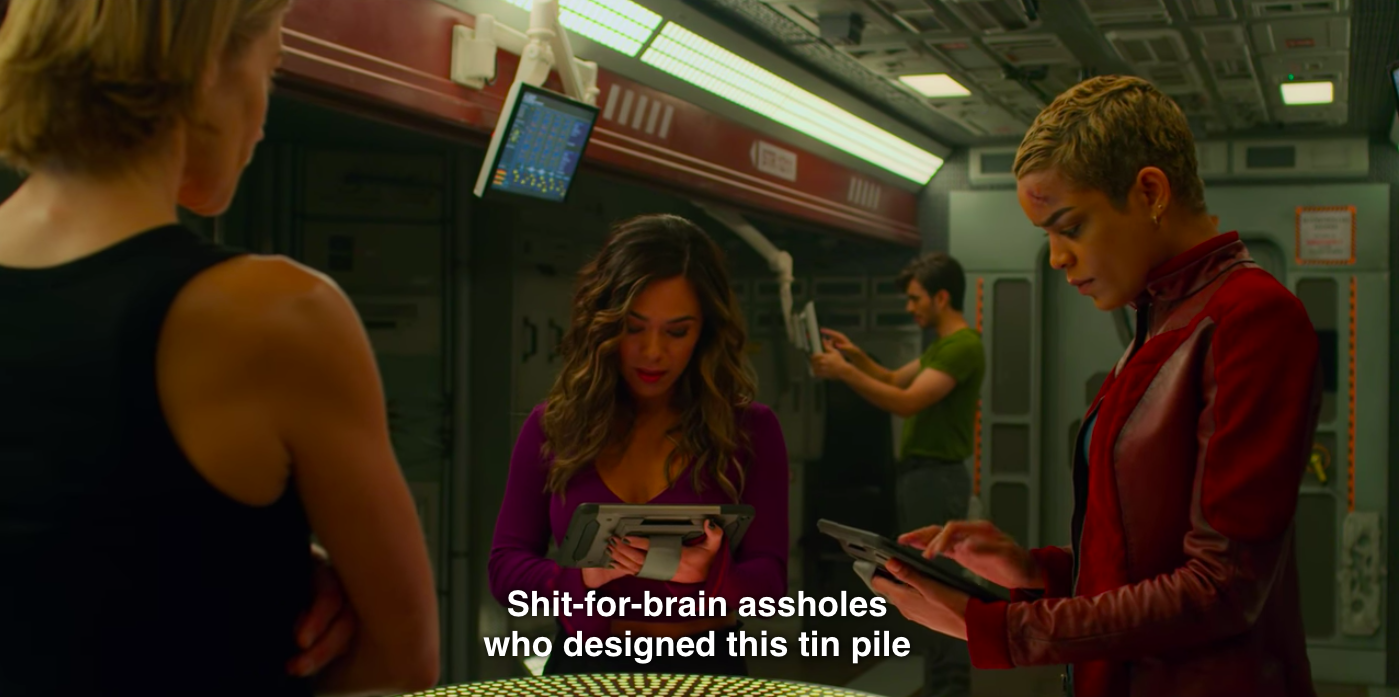
The infinity sign shaped spaceship seduced me to watch this, you have been warned, watch it at your own risk
Slaughterhouse Five by Kurt Vonnegut: A review
The semi-autobiographical book is an interesting take on the effect of war on soldiers. The book starts with the desire of the author to write a book about his experience of the war. He consults a friend for the same and we have the result. This novella set during the Second World War describes the journey of one American soldier Billy Pilgrim by one of his fellows. Billy is an optometrist, a trade he inherits from his father-in-law. He is enlisted during the war. Post war Billy claims he was abducted by aliens. These aliens called, Tralfamadorians, have a very different concept of time. They can see all time, past and future at the same instant, time travel. Once with them, Billy is able too do time travel too, post an experience during this 18th anniversary. Hence in the book he goes off to different timelines and places, which others see as him hallucinating. He switches between his childhood, his youth, his war years and his old age.
> And I asked myself about the present: how wide it was, how deep it was, how much was mine to keep.
> There is no beginning, no middle, no end, no suspense, no moral, no causes, no effects.
Due to this the book has a highly non-linear timeline. It goes from hospitals to war theatre and hospital to his office. So it goes.
Billy already knows things that will happen to him and others. For example, he already knows about the plane crash, in which he and a co-pilot are the only survivors. At other times even in case of hig distress situations he keeps his calm. So it goes.
> He was so snug in there that he was able to pretend that he was safe at home, having survived the war, and that he was telling his parents and his sister a true war story—whereas the true war story was still going on.
The Tralfamadorian philosophy is completely deterministic in a sense.
> “He has always pressed it, and he always will. We always let him and we always will let him. The moment is structured that way.”
The book starts the story with capture of Billy by the Germans. They are temporarily stationed at a PoW camp with Russians and the British soldiers. The American soldiers are seen as the worst of the lot, and are deemed to be no good soldiers at all. The British soldiers are a class apart from the ragged Americans. The Brits have maintained themselves well, and have huge stocks of food and other items which were sent to them by a clerical mistake. They are eating the best food, arguably in all of Germany. Billy finds his attire in the form of a azure toga and shoes. He looks distinct and clownish. The Americans are subsequently transferred to Dresden, the only German city, which has been spared of aerial bombardment as it does not have any industries of repute. So it goes.
In Dresden, most of the daily routines are unaffected by the war. The city itself is in all its glory. The Americans are stationed in Slaughter House Five.
> “ Their address was this: “Schlachthof-fünf.” Schlachthof meant slaughterhouse. Fun/was good old five.”
The Slaughter house was empty, as most of the animals were already eaten. The Americans are guarded by a motley group of Germans who seem to be masquerading as soldiers. They are either too young, or too old or too unfit to be soldiers in the real sense. Almost everyone has lost their sense of belonging and are like lost souls. Then one night, bombing does happen. They go into a deep bomb shelter, while rest of Dresden is destroyed. The group comes out in the noon next day to see the entire city in rubble. They say it is moon, as ashes and stones are everywhere. Afterwards the Americans are made to dig bodies from under the debris. Till finally they are released at the end of the European theatre of war.
> One of the main effects of war, after all, is that people are discouraged from being characters.
There are a few characters worth mentioning in the book. One is the sci-fi writer named Kilgore Trout.
> He did not think of himself as a writer for the simple reason that the world had never allowed him to think of himself in this way.
An episode witnessed by Trout at Billy’s 18th wedding anniversary leads to all his theories about the Tralfamadorians. Thereafter it is a downward slide for Billy. Another character is the actress named Montana Wildhack. She is a famous actress and is abducted to give Billy company during his stay at Tralfamador. They copulate and have a baby, and their act is a crowd puller for the Tralfamadorians. She comes in Billy’s time travel episodes often.
Overall the non-linearity of story line and the brutal senselessness of war and violence are interesting to read. The simplicity of Billy, whether from a bit of dementia or due to his contact with Tralfamadorians is truly hilarious.
Review of His Master’s Voice by Stanislaw Lem
The book is an autobiographical tale by one of the mathematician-scientist who looks at a mysterious signal from the cosmos. The title is from the title given to the top secret project which tries to decipher this signal. The signal in the form of a neutrino stream is discovered accidentally and is hidden well in the general noise of neutrino signal. Only if you know where to tune in to is the signal readable/recordable/visible. The signal is attacked upon by a team of experts from different domains like physics, chemistry, biology, language, mathematics. They are able to know that the signal has an “alphabet” but are not able to crack the code as a whole. Though they discover some properties of the signal to interact with matter. For example, they discover that this letter from cosmos has a positive effect on the formation and consolidation of large protein molecules. They also discover a “recipe” for building a substance which is dubbed as “Frog Eggs” and “Lord of the flies”. This substance with a consistency of frog eggs can absorb energy from radioactive fission within itself and has some peculiar properties.
even though, receiving the message from the stars, we did with it no more than a savage who, warming himself by a fire of burning books, the writings of the wisest men, believes that he has drawn tremendous benefit from his find!
That not withstanding, the entire operation is under government supervision and there are plots and counter-plots of bureaucracy enmeshed within the narrative. This also includes an effect termed as “TX” in which a small nuclear detonation can have its energy transmitted to another place. But large scale implementation fails as the energy is dissipated over a very large area rendering any weapons created from them unusable. After these initial success, there is not further “code-breaking” possible and things come to a standstill
We are proceeding like a man who looks for a lost thing not everywhere, but only beneath a lighted street lamp, because there it is bright.
They also discover there is another parallel team working on the same problem but under the command of the military. Finally, the two units are merged.
At this point, various theories are put forth which try to explain the origin of the “letter”. Doubts are even raised to know if the signal is “natural” or “artificial”. One of the military members uses the oscillating universe model to suggest that the neutrino signal is information from the past universe, from a ‘fissure” in between the universes, to the current one. One more hypothesis is given in the form that the frog eggs naturally evolved and the neutrino signal is just a by-product and the “organisms” do not know if this signal is being sent. A closer example of this is plants doing photosynthesis, they are not aware that their photosynthetic activity is helping other organisms grow, they do it nonetheless.
And surely it was unintentional on the part of the grass to give us the opportunity to exist!
While the author genuinely believes that the signal is from a very old and highly evolved “civilisation”, and we are at a stage such that we cannot understand the letter fully. We are not meant to, not at this stage of our technological evolution. The signal has been there for billions of years, and it takes an enormous amount of power (at least by our standards) to send it, so whoever (or whatever) is sending it must have a purpose, just that we don’t know ( and perhaps will never know) what the purpose is.
We will make it undecipherable for all who are not yet ready; but we must go further in our caution — so that even a false reading will not be able to supply them with any of the things that they seek but that should be denied them.
The book is an interesting take on the status of technological progress and its ramification for civilisation as a whole. Some of the themes that one can identify is the survival of the species and not of a particular nation. The concerns expressed over the “TX” discovery make the smaller group privy to this very anxious as we would then have a weapon which at the speed of light can deliver an atomic explosion anywhere. Some of the musings about the senders of the signal and the kind of evolution the civilisation that must have are interesting to read.
The Textbook League
I came across this site while reading an article, there are interesting reviews of textbooks used in schools. And some of these reviews are gory, splitting out the blood and guts of the textbooks and their inaneness. Hopefully, many people will find it useful, though the latest book that is reviewed is from about 2002. Perhaps one should do a similar thing for books in the Indian context, basically performing a post-mortem on the zombiesque textbooks that flood our schools.
The Web site of The Textbook League is a resource for middle-school and high-school educators. It provides commentaries on some 200 items, including textbooks, curriculum manuals, videos and reference books. Most of the commentaries appeared originally in the League’s bulletin, The Textbook Letter.
http://www.textbookleague.org/ttlindex.htm
Review of I Am A Strange Loop by Douglas Hofstadter – Part 2
Part 1

The toilet flush is one of the simplest and common feedback mechanisms that we find. There is a float which rises with the water level which controls the inflow of water. After a certain height is reached the water inflow is stopped. Do we attribute intentionality to the water flush? We usually do not. And this is the theme that Hofstadter explores in Chapter 4 Loops, Goals and Loopholes.
But what kinds of systems have feedback, have goals, have desires? Does a soccer ball rolling down a grassy hill “want” to get to the bottom? 52
We anthropomorphize objects and impart them our human attributes. Adding a “purpose” or a “goals” to any system is considering it from a teleological perspective. Teleology is the explanation of phenomena by the purpose they serve rather than by postulated causes. Considering examples of variations on this theme, we can say that answer to the above question is not clear cut. There are no black-and-white answers but are judgment calls. We tend to move towards the idea of teleology and intention for a system when the feedback mechanisms are not directly perceptible.
Among other examples, Hofstadter considers plants which in normal time will appear to be static and without any “goals”. But a time-lapse of the same would show that they have “goals” and “intentions” and use strategies to achieve them.
The question is whether such systems, despite their lack of brains, are nonetheless imbued with goals and desires. Do they have hopes and aspirations? Do they have dreads and dreams? Beliefs and griefs? 53
The claim is made that presence of a feedback loop in a system, triggers in us a response which shifts the description from a goalless level of mechanics to a goal-oriented level of some cognitive mechanism. Things have the desire to move!
So far we have considered basic feedback loops. Now we move onto a more complex idea of a positive feedback loop. In a positive feedback loop, a part of the output of the system goes into increasing the output by a certain factor. With each iteration the output increases, which causes the next output to increase even more. A small change in input can cascade into a very large change (exponential) in output.
Perhaps the most common example of a positive feedback loop is the unpleasant, high pitch sound one hears in an auditorium or a meeting. This happens when a microphone gains some of its output as an input and produces an ever increasing pitch and volume of the input sound. An example is given below:
Now one can imagine that due to the exponential nature of growth, any little disturbance in such a system might lead to a sound which will eventually destroy everything.
In theory, then, the softest whisper would soon grow to a roar, which would continue growing without limit, first rendering everyone in the auditorium deaf, shortly thereafter violently shaking the building’s rafters till it collapsed upon the now-deaf audience, and then, only a few loops later, vibrating the planet apart and finishing up by annihilating the entire universe. What is specious about this apocalyptic scenario?
But this is a fallacious argument. The first fallacy is the physical nature of the setup and the amplifier in our scheme of things. If the roof falls, it will destroy the amplifier too! The second case is the nature of the amplifier, it doesn’t amplify in an unlimited way. After a certain gain, due to the physical design, the amplification becomes equal to unity and the system stabilizes at its natural frequency. It so happens that the natural high frequency of an audio amplifier is close to a high pitch scream. This is achieved by the system tends to go towards that pitch in series of rapid iterations. These are the screeching high pitch oscillations that we hear. It seems the systems “wanted” to go there, the stable point of its existence. Thus we see that
Similarly, we can also “see” visual feedback loops, when the output of a camera is given back to the camera. This can be most easily setup by pointing the camera towards a screen which is showing a live output of the camera. The cover image of the book is one such image, captured during Hofstadter’s “experiments” with the visual feedback system. One of the difference, in this case, is that the camera is not an amplifying device, it just transmits. Yet the pictures it produces are bizarre and beautiful. Seeing images of video feedback gives one a sense of mystery and wonder. There is some inherent beauty in it, yet it seems un-natural to watch.
Feedback — making a system turn back or twist back on itself, thus forming some kind of mystically taboo loop — seems to be dangerous, seems to be tempting fate, perhaps even to be intrinsically wrong, whatever that might mean. 57
Shifting gears, we get a Hofstadter’s introduction to Gödel when he was fourteen. What intrigued him was the thought that one could have an entire book about a single book. The book was Nagel and Newman’s Gödel’s Proof, published in 1958. Hofstadter wrote the introduction to the new imprint in 2001. He was fascinated by footnote on formal use of quotation marks.
So here was a book talking about how language can talk about itself talking about itself (etc.), and about how reasoning can reason about itself (etc.). I was hooked! I still didn’t have a clue what Gödel’s theorem was, but I knew I had to read this book. 58
This is something that happens to me too. Some time back (almost a decade now) I had posted about books attracting me. Perhaps it happens to many people.
We next look at famous Russel’s Paradox. One of the examples derived from it is Barber’s Paradox
The barber is the “one who shaves all those, and those only, who do not shave themselves.” The question is, does the barber shave himself? [.]
There is also a loop here and there is contradiction too.
This loophole (the word fits perfectly here) was based on the notion of “the set of all sets that don’t contain themselves”, a notion that was legitimate in set theory, but that turned out to be deeply self-contradictory. 60
Russell tried to overcome this by formally re-defining the concepts of sets to save this, but it didn’t work out well. Rather it became too complex, though built on solid, atomic (in the mathematical sense) ideas.
In Principia Mathematica, there was to be no twisting-back of sets on themselves, no turning-back of language upon itself. 61
But why is self-reference considered problematic? Here Hofstadter quotes from his column Metamagical Themas (an anagram of Martin Gardner’s Mathematical Games) in Scientific American on Self-Referential sentences. But all were not receptive to the idea, some of the readers were sceptical about the utility of self-reference and denied any meaningful output of such activities.
In the next chapter On Video Feedback we explore the theme of video of video feedback and Hofstadter’s experiments with it. He explores and explains many of the images which were made by adding slight things in the image, fox example, truncated corridor, endless corridor, helical corridor etc. The common element in all these video feedback is the repeating of the primary image in scaled down fashion till the resolution of the screen can support (theoretically infinite). During one the experiments, he covers the lens and then removes his hands. During this, the movement of his hand is captured and forms an endless image which is moving, even when the hand is removed. This action has formed a loop and is feeding itself in a cyclic setup.
A faithful image of something changing will itself necessarily keep changing! 67
A similar phenomenon is that of dogs barking in sync. Some dog somewhere, starts to bark for something that is passing near it. Now, other dogs pick up and start barking too. And the chain goes on. Once setup, it doesn’t matter what was the reason for the first dog to bar, it may have gone away. But the chain of barking sustains itself. During one the flights, I have seen this happen with small babies. There were about 5-6 babies on the flight. It so happened that one of them started to cry for some reason. Then the rest joined in one-by-one. Perhaps the others were crying because the heard another one cry. And the event became self-sustaining. This went on for quite some time.
This is one of the core idea of an emergent phenomenon, once
In general, an emergent phenomenons omehow emerges quite naturally and automatically from rigid rules operating at a lower, more basic level, but exactly how that emergence happens is not at all clear to the observer. 68
The video explorations led to some fantastic images, many of which are reproduced in color in the central pages of the book. In the last part of the chapter, Hofstadter drives towards one of the central themes which we will explore in the remaining book. The idea is that strange and robust (self-sustaining) structures can emerge from the process of looping.
Once a pattern is onthe screen, then all that is needed to justify its staying up there is George Mallory’s classic quip about why he felt compelled to scale Mount Everest: “Because it’s there!” When loops are involved, circular justifications are the name of the game. 70
Some of the images I myself have collected are shown below:
The locking-in gives rise to abstract phenomena at higher levels.
In short, there are surprising new structures that looping gives rise to that constitute a new level of reality that could in principle be deduced from the basic loop and its detailed properties, but that in practice have a different kind of “life of their own” and that demand — at least when it comes to extremely finite, simplicity-seeking, new level of description that transcend the basic level out of which they emerge. 71
Whether we will be able to actually do it, or want to do it is another question. This reminds me of the saying: In theory, there is no different in theory and practice, in practice there is.
Here are a few more:
Delhi 6
जाने किस रंग में रंगे, हमाम में हम सारे नंगे



